Current Profile: Tabung Haji
Deposits: From a modest start with 1,281 depositors in 1963 and a total of RM46,600 (US$12,000) in deposits collected through its three branch offices, Tabung Haji has now grown into a big corporate body with almost 4 million depositors and more than RM7 billion (US$1.8 billion) deposits. While it has now more than 100 branches throughout the country and has plans for further expansion.
 Figure 4: Current Profile
Figure 4: Current Profile
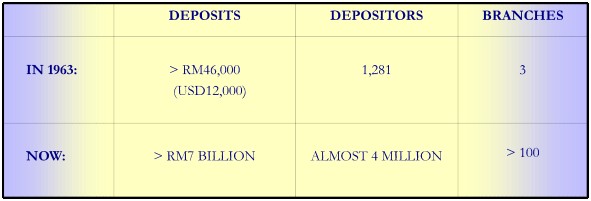
Market Share (Depositors): Th market share in terms of depositors as a percentage of the Malaysian Muslims population is constantly on the increase. Data for the last few years show that Malaysian Muslim population has increased from 11.9 million in 1995 to 12.8 million in 1998. Market share for Th during the same period has also increased from 23% (2.7 million depositors) in 1995 to 27% (3.4 million depositors) in 1998. Th is targeting to have 50% of Malaysian Muslims (about 6.5 million) depositing their money with Th in the next 10 years time. This goal seems easily achievable as the present growth rate in Th depositors of 8.1% per annum far outweigh that of the growth in Muslim population, which is at 2.5% per annum.
Figure 5: Market Share
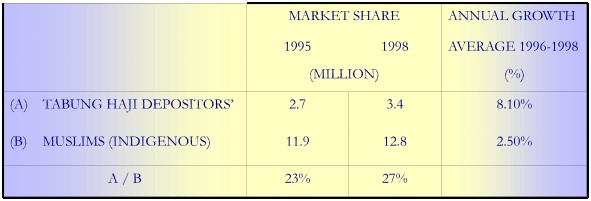
Assets: Th assets are also on increase. In 1998, these were worth more than RM7 billion (US$1.8 billion). This was despite the fact that the impact of Asian Economic Crisis (1997-8) resulted in lower asset growth in the industry as a whole. As such, the non-bank financial institutions, a segment that is comparable to Th, experienced a major decline in the annual asset growth, i.e. from 36% in 1996 to minus 12% and minus 3% in 1997 and 1998, respectively. Though Th also experienced a decrease in the asset growth, the rate is never below zero. In fact the growth is remarkably and relatively high, i.e. 37% in 1996 and lower to 30% and 19% in 1997 and 1998, respectively. As a result, Th’s share of the industry’s assets increased from 5% in 1996 to 10% in 1998.
The fundamental concept behind Th’s establishment was to enable Muslims save for pilgrimage without any fear of their money being tainted by riba. That still remains. Furthermore, Th has been encouraging Muslims to save not only for Hajj but also for investment purposes and in the process earn profit out of their savings. To date, Tabung Haji is able to provide not only efficient Hajj and deposits services but also attempts to generate reasonable returns on their investments.
Figure 6: Assets

Portfolio: Tabung Haji is also actively involved in a variety of economic enterprises namely; capital market, commercial, industrial, housing development and plantations. Th’s portfolio as on Dec. 31, 1998 was RM3.5 in equity comprising investment in listed shares and direct investment in subsidiaries, RM1.8 billion in Islamic money market and RM0.7 billion in property investment. Translated into ratios, equity represents 58% of the portfolio with money market and property representing 31% and 11%, respectively.
Figure 7: Portfolio
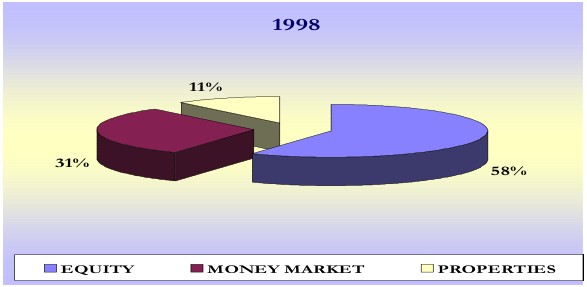
Profit: As for the profitability, Th earned impressive growth over the years and quite evidently seems to continue to do so in future as well. As any other economic organization in the region, Th was also not spared from the Asian Economic Crisis. The profit growth was a bit lower compared to that of the pre-crisis level, nonetheless, it earned a remarkably high profit of RM576 million (US$152 million) in 1998.
 Figure 8: Profit
Figure 8: Profit
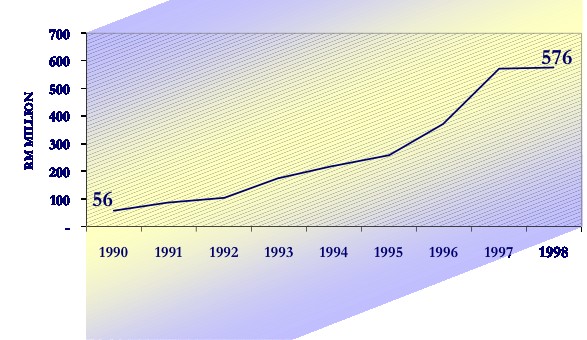
Dividend (Bonus): The bonus paid by Th to depositors is based on the principle of profit sharing that differentiate it from the concept of riba. Thus, the bonus is only paid if Th makes profit. The percentage of the bonus depends on the profits derived in a particular year. Th’s healthy profit over the recent years has enabled it to pay competitive bonus to its depositors well above market rates. It is significant to note that in 1966, within only 3 years of its inception, Tabung Haji was able to pay a 3% bonus to its depositors. Since then there has never been a year without bonus. Rather the rates have increased ranging between 4 to 9.5% excluding another 2.5% payment for zakat (tithe) which is paid by Tabung Haji on behalf of its depositors.
Figure 9: Bonus (per cent)
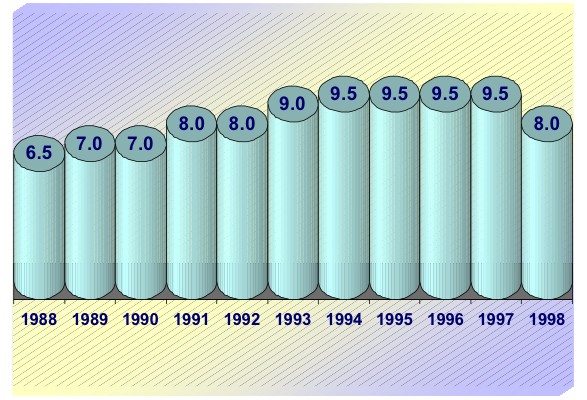
Source: Towards Islamic Banking: Experience and Challenges, Institute of Policy Studies. Republished with permission.
Search our Resources or Dictionary
Islamic Economics and Economics
Rate Of Return as a Discount Rate Under Uncertainty
Additional Methods for Dealing with Uncertainty in Project Evaluation
Address on Monetary & Fiscal Economics of Islam
Allocation of Risk Through Mudarabah
An Appraisal of Monetary Policy
An Islamic Perspective on Discounting
Basic Features of Islamic Economics
Behavioral and Institutional Setting
Capitalist Accumulation or Globalization
Capitalist System: Some Deficiencies
Changes Taking Place in Conventional Economics
Characteristics of an Islamic Economy
Collapse of Communism & Rise of Capitalism
Commentary on Monetary Policy in an Islamic Economy
Comments on Current Islamic Banking
Comments on Discounting of in Project Evaluation
Comments on Fiscal Policy in an Islamic Economy
Comments on Risk-Bearing & Profit-Sharing in an Islamic Framework
Comments on the Elimination of Interest from Economic and Finance System
Comments on the Financial and Monetary Structure for an Interest Free Economy
Comments on the Foundations of Taxation Policy
Comments on the Objectives of Fiscal Policy
Comments on the Rate of Capitalisation in Valuation Models in an Islamic Economy
Comments on the Theory of Fiscal Policy
Comparison with the Welfare State
Contemporary Economic Challenges & Islam
Contrasting Islamic & Marxist Positions on Discounting
Contributions in Eighties & Nineties
Conventional Economics & its Drawbacks
Desirable Strategy for Isalmization
Discount Rate in the Theory of Corporation Finance
Discounting for Public Projects
Discounting Under Uncertainty for a Private Investor
Discussion on the Financial and Monetary Structure for an Interest Free Economy
Discussion on Current Islamic Banking
Discussion on Discounting of in Project Evaluation
Discussion on Fiscal Policy in an Islamic Economy
Discussion on Monetary Policy in an Islamic Economy
Discussion on Risk-Bearing & Profit-Sharing in an Islamic Framework
Discussion on the Elimination of Interest from Economic & Finance System
Discussion on the Foundations of Taxation Policy
Discussion on the Objectives of Fiscal Policy in an Islamic State
Discussion on the Theory of Fiscal Policy
Distinguishing Characteristics of an Islamic Economy
Distributional Implications of Interest Receipts & Payments of the Government
Economic Integration: Islamic Approach
Eliminating Interest from Loans to Provincial Governments and other Government Agencies
Elimination of Interest: Pakistan
Evaluating the Proposals to Eliminate Interest from Government Transactions: Pakistan
Facing Globalization: Setting the Muslim Mindset, Malaysia
Financing Government Transactions in an Interest-Free Economy
Financing Govt Transactions in An Interest-Free Economy: A Case of Pakistan
Fiscal Policy & Allocation of Resources
Fiscal Policy & Economic Stabilization
Fiscal Policy & Income Distribution
Fiscal Policy in an Islamic Economy
Fiscal Policy, Economic Growth & Development
Generating Research Priorities
Globalization & a Universal Approach
Globalization & its Significance
Globalization Domination of Finance
Globalization The US and the World Dollar
Globalization: Blessing or Blarney?
Globalization: MNCs & TNCs: Their Role & Socio- Economic Impact on Host Societies
Globalization: Role for Muslims
Globalization: Some Ground Realities
Globalization: Some Ground Realities & an Islamic Response
Globalization: Some Reflections
Government Expenditures on Interest: Pakistan
Growth, Stability & Resource Allocation
Higher Education & Research: Trends & Challenges in a Globalized World
Human Financial Needs & their Fulfillment
Impact & Achievements: Tabung Haji
Imperialism Today & Globalisation
Imperialism, Capitalism, Technology & Science
Implicit Strategy for Islamization
Inaugural Address on Monetary & Fiscal Economics of Islam
Interaction with Shari‘ah Scholars & Economists
Interest Payment to State Bank of Pakistan
International Financial Stability: The Role of Islamic Finance
Islamic Economics & Shari’ah Sciences
Islamic Economy: Three-Sector Model
Islamic Financial System: Malaysia
Islamic Tradition in Economics
Islamization of Finance Sector: Pakistan
Issues, Problems and Strategy: Riba
Journey From Equality To Impoverishment
Keynote Address on Monetary & Fiscal Economics of Islam
Legislative Changes in Islamic Finance
Malaysian Muslim Malaise: Globalization
Measures of Fiscal Policy in an Islamic Economy
Minimising the Budget Deficit: Pakistan
MNCs & TNCs: Emergence, Stakes & Strategy
MNCs: Impact on Host Societies
Monetary Policy in an Islamic Economy
Moral & Ethical Dimension: MNCs & TNCs
Muslims' Preparedness for Globalization
Nature and Content of Islamic Economics
Necessary New Mindset: Globalization
Need for Justice, Mutual Help & Cooperation: Islamic Approach
New World Order & Globalizaton
Objectives & Instruments of Monetary Policy
Objectives of Fiscal Policy in an Islamic Economy
Permissible vs Forbidden Discounting
Positive Time Preference as Basis for Discounting
Poverty from the Wealth of Nations
Practical Options for Central & Commercial Banking
Principle of Inclusion & Exclusion
Required Rate of Return in an Islamic Economy
Risk Allocation & Productive Efficiency
Risk-Bearing & Profit-Sharing in an Islamic Framework: Some Allocational Considerations
Self-Reliance & Elimination of Riba
Seminar Address on Monetary & Fiscal Economics of Islam
Shadowy Argument for Using a Shadow Interest Rate
Size of Interest Receipts and Payments: Pakistan
Social Integration with Cultural Diversity: Islamic Approach
Sources of Finance for Present Muslim States
State of Economic Disparity & its Reason
Stochastic Productivity of Investment as Basis for Discounting
System Constraints on Taxation
The Contemporary Scene of Economics
The Core Issue & its Redressal
The Knowledge-Based Economy: Malaysian Response
Theory & Practice of Interest-Free Banking
Theory of Income Determination
Theory of Islamic Economic: The Future
Theory of Islamic Economics: Essentials
Three Levels of Interventions: MNCs & TNCs
Unification of Mankind & Globalization: Islamic Approach
Values & Markets in Islamic Allocation
Way Ahead for Muslims: Globalization
Workers’ Participation in the Income Risks of the Firm
Pakistan Supreme Court Challenges
Pakistan Supreme Court Response to Challenges
Issues in Pakistan Supreme Court Response
Evaluation of Pakistan Banking Changes
Legal and Practical Constraints: Tabung Haji
Legal Reforms In Pakistan: 1979-89
Issues of Implementation: Zia’s Nizam-i-Mustafa
Structural Reforms in Pakistan's Legal System
Procedural Reforms: The Qanoon-i-Shahadat
Benazir Bhutto & Islamic Reforms
The Status of Women in Pakistan
Social & Political Costs: Zia's Reforms
Repugnancy to Islam - Who Decides?
Zia's Raj: The Politics of Prudential Islamization
The Objectives Resolution & Pakistan’s Constitutions
Objectives Resolution: The Argument
Relevant Case Law, For & Against: Supra-Constitutionality
Pre-Emption & Land Reforms: 1978-92
The Fate of Tenants' Right to Pre-emption: Pakistan
Raising the Ceiung: Fate of Land Reforms
Judicial Activism After Zia: Riba Elimination
Educating the Public on the Merits of Interest-free Economy
Objectives Resolution and Riba
The Faisal Case: Findings and Implications
The Variables and Nonvariables in Legal Thought
The Secularized Muslim Elites' Dilemma
Implementation of Hudood Ordinances
Types and Disposition of Cases
Region and the Hudood Ordinances
Gender and the Hudood Ordinances
Social Aspects & Environmental Concerns
Global Peace & Justice: An Islamic Perspective
Global Peace & Justice: The Christian Perspective
Development of Modem International Law in the West
Socio-Economic Justice: its Place in Islam
Justice in Pakistan & the Muslim World
Justice: The Role of Moral Values, Government & the Hereafter
Democracy & Justice in the Muslim World
Legal Framework for an Islamic Financial System
Review of Pakistan Federal Shari’ah Court Judgement on Riba
Islamic Law of Contracts and Gharar
Selection Criterion for Shari’ah Advisory
Shari’ah Aspects of Salam Contract
The Financial Market Instruments
The Financial Market & Equilibrium
Indexation of Bank Deposits & Advances
Financing on Normal Rate of Return
Methods to Finance Alternative Mechanisms
Alternative Mechanisms to Replace Riba
Specialised Financial Institutions: Pakistan
Central Banking & Monetary Policy: Pakistan
Government Transactions: Pakistan
Interim Report on Elimination of Interest
Malaysian Islamic Financial Landscape
Islamic Financial Intermediaries: Malaysia
Non-bank Islamic Financial Intermediaries: Malaysia
Malaysian Authorities & Islamic Banking
Genesis of Islamic Banking in Bangladesh
Role of Bangladesh Central Bank
Legal and Practical Constraints: Bangladesh
Achievements, Impacts and Prospects: Bangladesh
Principles of Distribution of Profit to Mudarba Depositors
Current Approach to Interest-Free Financing
Participation Term Certificate
Prospects for International Transactions Without Riba
Criteria for Appraisal from the Riba Angle
Scope & Coverage of the Ahkam on Riba
Islamic Position of Foreign Exchange Transactions
International Trade: Exports and Imports
Need for Four-Pronged Effort: Riba Elimination
Selected Riba-Safe Transaction Modes
Promotion of a Riba-Safe Business Environment
International Capital Movements
International Transactions at Government Level
Theoretical Basis of Islamic Banking
Evolution of the Concept & Practices: Islamic Banking
An Early Experiment: Islamic Banking
Business Practices of Islamic Banks
Sources of Funds of Islamic Banks
Some Misconceptions of Islamic Banking
Current Status of Islamic Financial Institutions Number of IFIs
Experience of Islamic Banks: Some Conclusions
Main Conclusions Nature of Riba
Elimination of Riba: Concept & Problems
Riba & Contemporary Transactions
Riba Elimination & Foreign Loans
Achievements & Failures: Pakistan Financial System
Present State of the Islamisation of the Financial System in Pakistan
Profit-Sharing Arrangement with Depositors
Islamic Instruments for Secondary Reserves
Central Bank’s Role as ‘Lender of the Last Resort’
Inter-Bank Flow of Funds or Inter-Bank Call Money
Provident Fund Balances of the Employees
Foreign Branches of Pakistani Banks
Riba-Free Alternatives in Commercial Banking
Interest-Free Banking: A Proposal
Islamic Financial System: A Brief Introduction
Role of Mudarba Floatation’s in Pakistan’s Capital Markets
Islamic banks as financial intermediaries
Shari’ah Maxims Relevant to Islamic Banking
The Role of Shari’ah Advisors in Islamic Banking
Limits to Shari’ah board participation in the day to day business of an Islamic bank
Historical Development: Tabung Haji
Services & Operations: Tabung Haji
Fund Mobilization: Tabung Haji
Saving Procedures: Tabung Haji
Distribution of Profit: Tabung Haji
Investment Principles: Tabung Haji
Investment History: Tabung Haji
Investment in Equities: Tabung Haji
Investment in Islamic Financial Instruments: Tabung Haji
Investment in Land & Building: Tabung Haji
Investment in Shares – Criteria
Reserves in Islamic Equity Funds
Equity Funds - Guarantee of capital of the fund by the manager
Poverty: Some Points to Ponder
Child Labour: Nature, Concerns, Reasons & Elimination Measures
Concerns Raised on Child Labour
Unemployment, Underemployment & Poverty
Educational Institutions & Education System
Indifferent Attitude of Parents & Society
Absence of Any Formal Social Security Mechanism
Revamping School Education & Vocational Training
Labour Market Information System (LMIS)
Preparation of an Employment Policy
Special Focus on Poverty Alleviation
Elimination Projects & Rehabilitation of Child Labour
Other Measures to Tackle Poverty
Case Of Pakistan: Critical Issues
Welfare & Production: A Sequential Approach
Small Farmers’ Low Productivity Trap
Institutional Buildup at Grassroots
Land & Water Resources Potential
Population - Evidence from History
Factors Affecting Poverty in Pakistan
Broad-Basing of Growth for Poverty Reduction
Inflation and Poverty Alleviation
Tax structure, Public Expenditures & Poverty Alleviation
The Existing Poverty Situation
Poverty in an International Context
Growth, Employment & Poverty Alleviation
Trends in Rural & Urban Poverty: Pakistan
Growth & Unemployment in Historical Perspective
Growth, Poverty & Unemployment Scenarios
An Evaluation of Public Strategies & Policies
Functional Income Distribution & Poverty
Growth of Employment in Pakistan
Public Expenditure & Income Transfers
Strategy for the Future: Pakistan
Non-Farm Loans in Rural Sector
Pakistan Poverty Assessment: The World Bank Document
The World Bank's Casual Approach
The Question of Policy, Poverty and Society
Government of Local Elite (Shurafa)
Poverty Alleviation & Social Action Programme
Poverty Alleviation Role of NGOs
Role of NGOS in State, Economy & Society
The Role of NGOS in Poverty Alleviation
Productive Empowerment of the Poor
Poverty Alleviation & Income Distribution – The Malaysian Way
Poverty and Economic Inequality: Malaysia
Progress in Poverty Eradication: Malaysia
Progress in Income Distribution: Malaysia
Planning for Growth and Equity: Malaysia
The Future – Vision 2020: Malaysia
Grameen Bank: An Innovative Project
Historical Perspective Reference to the Ottoman Case
Business Partnership: Ottoman Case
Prohibition of Barter & Pilgrimage: Ottoman Case
Poverty in Developing Countries (1985)
Magnitude of Poverty in the Muslim World
Zakah: Remedy for Poverty in Islam
Role of Zakah in Combating Poverty
Islamic Development Bank: Role in Member Countries
The Impact of Zakah & Ushr: Pakistan
Impact of Zakah & Ushr on Poverty Alleviation
Contribution of Zakah & Ushr to the Average Disposable Income of Lower-Income Deciles
Zakah and Ushr System: A Review
Cash Waqf: Shafi’i & Hanbali Positions
Cash Waqf: The Shi’ite Position
Original Capital of Endowment (corpus)
Centralization of the Waqf System
Waqf Centralization: Ottoman Empire & Turkey
Waqf Crisis: Late Ottoman Era and the Republic
Survival & Restoration of Waqfs in Turkey
Beneficiaries & the Family Waqf
Cash Waqfs in the Ottoman Economy
Cash Waqfs in Malaysia and Singapore
Decline of the Ottoman Cash Waqfs
Egyptian Waqfs Under the Mamluks
Egyptian Waqfs Under the Ottomans
Waqf Administration in Malaysia
Waqfs During The Turkish Republic
Central Waqf Act, 1954 (India)
Waqfs in Malaysia and Singapore
Waqfs in Pakistan & Bangladesh
Comments on Pakistan Supreme Court Judgement on Riba & Tabung Haji
Islamic Derivatives: Paradox or Panacea?
Islamic risk management: types, trends & issues
Islamic Banking Services in Malaysia
Integrating Money in Capital Theory
Mosa’qaat Contract in Islamic Finance
Direct Investment and Islamic Syndication
Properties of Money in Islamic and Conventional Settings and the Effect on Society
Classification of Islamic Modes of Contract
Capitalist vs Islamic Economic System
Islamic Banking Can Save Capitalism (Part 1)
Islamic Banking Can Save Capitalism (Part 2)
The Role of the Central Bank in Islamic Banking
Sukuk and Tawarruq Contracts in Islamic Finance
Hammoudi puts the problem this way:
Direct Investment and Islamic Syndication
Salam Contract in Islamic Finance
The Jo’aalah Contract in Islamic Finance
Hire-Purchase (Leasing) in Islamic Finance
Civil Partnership in Islamic Finance
Example of the Harmful Effect of an Interest-Based Economy (United States)
Mozara’ah Contract in Islamic Finance
Going Back to the Basics with Islamic Finance
Istisna’a Contract in Islamic Finance
Society and Cooperation in Islam: Incentives and Consequences
Speculation, Uncertainty, Interest, and Unemployment
Conventional Bank as Loan House vs Islamic Bank as Finance House
Islamic Money and Banking: Integrating Money in Capital Theory
IRR (Internal Rate of Return) and Investment Project Appraisal
How Islamic banking narrows the gap between the rich and poor
A Legal Perspective Towards Islamic Finance
Money and Capital Reconsidered
Speculation and on Demand for Money in an Islamic Economy
Introduction to Islamic Economic System
The importance of the economic goals
The real nature of wealth and property
Difference between Islam, Capitalism and Socialism
Factors of Productions in Islam: Capitalist View
Factors of Production: The Socialist View
Factors of Production: The Islamic View
Distribution of Wealth in Islam
Definition and classification of Musharakah
Rules & Conditions of Shirkat-ul-Aqd
Uses of Musharakah and Mudarabah
Basic mistakes in Murabahah Financing
Features of a Conventional Bank

